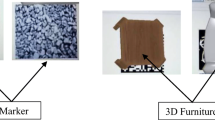Abstract
Interior design is important for the interior of a space to achieve a polished and more aesthetically pleasing environment. Engaging the services of an interior designer can be costly. Therefore, individuals who are not able to engage an interior designer tend to design their room or space by visiting furniture showrooms and social media sites for design ideas. However, individuals who lack experience in interior design might find it difficult to visualize the overall feel and look of the space and may lack the skills to estimate the dimensions of the space. Augmented-reality (AR)-enabled interior design applications offer the potential for individuals to design their room or space by enabling individuals to visualize and estimate the dimensions of the room or space. Although there are several AR-enabled applications for interior design, some limitations exist. As such, this research aims to develop a collaborative AR-enabled application for interior design (ARID) that overcomes the limitations of existing applications. Rapid Application Development Methodology (RAD) was used to develop the proposed AR-enabled application for interior design. The resulting ARID application for interior design overcomes the limitations of existing applications by allowing the user to view the furniture on both horizontal and vertical planes, change the wall and floor color, and enable multiple users to collaborate when designing the room or space. In addition, the fundamental features of allowing the users to select furniture and decoration from a menu of items and previewing the furniture or decoration for the room or space using AR were also developed. Feedback gathered from user acceptance tests revealed that the ARID application was easy to use and beneficial for individuals when designing their rooms or space. The ARID application benefits the field of interior design by overcoming the limitations of existing interior design applications and enables individuals to visualize the room or space they wish to design.
Access this chapter
Tax calculation will be finalised at checkout
Purchases are for personal use only
Similar content being viewed by others
References
Coleman, G., & Verbruggen, R. (1998). A quality software process for rapid application development. Software Quality Journal, 7, 107–122. Retrieved 28 June 2021.
Geambasu, C., Jianu, I., & Gavrilla, A. (2011). Influence factors for the choice of a software development methodology. Retrieved 24 June 2021.
Goode, L. (2017). Houzz has a new AR mode that lets you try furniture before you buy. The Verge. https://www.theverge.com/2017/5/3/15526478/houzz-3d-ar-home-renovation-furniture-shopping-app-update. Retrieved 29 June 2021.
Gürçınar, E., & Esen, Ö. (2018). The application of augmented reality in interior design education. Retrieved 24 June 2021.
Martin, J. (1992). Rapid application development. Macmillan.
Milgram, P., & Kishino, F. (1994). A taxonomy of mixed reality visual displays. IEICE Transactions on Information Systems, 77, 1321–1329.
Nasir, S., Zahid, M., Khan, T., Kadir, K., & Khan, S. (2018). Augmented reality application for architects and interior designers: Interno A cost effective solution. Retrieved 24 June 2021.
Ozturkcan, S. (2020). Service innovation: Using augmented reality in the IKEA Place app. Journal of Information Technology Teaching Cases, 11(1), 8–13.
Phan, V., & Choo, S. (2010). Interior design in augmented reality environment. International Journal of Computer Applications, 5(5), 16–21.
Sandu, M., & Scarlat, I. (2018). Augmented reality uses in interior design. Informatica Economica, 22(3/2018), 5–13.
Tan, P. (2013). Interior design using augmented reality. Retrieved 24 June 2021.
Tang, J., Lau, W., Chan, K., & To, K. (2014). AR interior designer: Automatic furniture arrangement using spatial and functional relationships. Retrieved 24 June 2021.
Wang, X. (2009). Augmented reality in architecture and design: potentials and challenges for application. International Journal of Architectural Computing, 7(2), 309–326.
Acknowledgements
We thank Xiamen University Malaysia for the financial support to present and publish this research paper.
Author information
Authors and Affiliations
Corresponding author
Editor information
Editors and Affiliations
Rights and permissions
Copyright information
© 2023 The Author(s), under exclusive license to Springer Nature Switzerland AG
About this paper
Cite this paper
Chen, X.Y., Kanaparan, G. (2023). ARID—An Augmented Reality Mobile Application for Interior Design. In: Krüger, E.L., Karunathilake, H.P., Alam, T. (eds) Resilient and Responsible Smart Cities. Advances in Science, Technology & Innovation. Springer, Cham. https://doi.org/10.1007/978-3-031-20182-0_1
Download citation
DOI: https://doi.org/10.1007/978-3-031-20182-0_1
Published:
Publisher Name: Springer, Cham
Print ISBN: 978-3-031-20181-3
Online ISBN: 978-3-031-20182-0
eBook Packages: Earth and Environmental ScienceEarth and Environmental Science (R0)




